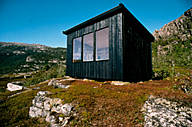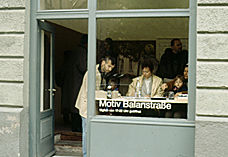

By Christiane Meyer-Stoll
Ólafur Gíslason’s objects have been turned inside out and back to front, they have become rooms, places for communication, where original creativity is to flourish. The representative objects, the white cubes, which up to now have been a constant element in the work of the Icelandic artist, are not to be found in his latest works.
In ‘Media Thule’ (1994) the object that Ólafur Gíslason has produced is a house. A simple house, built with traditional materials for its location, in the North of Norway, with wooden walls, roof, doors and windows. This house, in contrast to the surrounding natural landscape of rocks and fjords, is however not obviously art. You can enter the object, it fulfils the primal function of a hut to protect against all weathers. Similarly, the furnishings encompass the basic of human life: a table and chairs. However there is no bed, the room is functionally equipped, not for a everyday purpose but for an artistic one.
The body of the house lies at right angles to the fjord and from the land side is entered through a wall of shelves. On the fjord side the room is opened up by a three-part ‘panoramic window’. Running along this wall of windows there is a table and three chairs. The narrow side walls between the windows and the shelves are covered in cork tiles.
Ólafur Gíslason’s house can be interpreted as a image of the artistic process and a perceptive model: Enclosed on all sides, a person looks out through the window, the eyes of the house, onto the surrounding countryside. Placed behind these eyes is a receptive surface, the table, offering up tools for painting, drawing and writing. The impressions received are captured on this receptive surface. The outcome of this process is hung on the pinboards on either side of the table as a form of short-term memory which can be accessed at any time. When the short term memory becomes too full, the visual memories are stored away for posterity on the shelves.
The creative process indirectly demanded of an observer in the artist’s earlier works, by means of the objects’ empty spaces being left open to interpretation, is here directly the central focus. Using the means available, a visitor to this work of art is supposed to perform a creative act, inspired by the artist and influenced by the view presented there. The means belong entirely in the sphere of ‘ordinary’ artistic activity, such as you would find in an art class, namely paper, lead pencils, coloured pencils, felt tips, wax crayons and water colours.
The object ‘house’ created by the artist has a potential which does exist but is realised only by the actions of its visitors. The arrangement upon which the artist has settled thereby resembles a set of instructions. The result produced by following these instructions are part of the work of art. the boundary between artist and observer, between the work of the artist and the work of the observer becomes meaningless. Through the entire process of origination, from the search for a location, the first discussions, working with local workmen, clashes with the neighbours, the opening and the use of the room there has emerged a ‘social sculpture’.
With the piece ‘Medium St. Pauli’ (1995) Ólafur Gíslason has created a similar sculpture in Hamburg. He installed ‘objects’ in nine different bars in the entertainment district of St. Pauli: pinboards with writing surfaces and boxes of drawing materials. The basic form of a desk suspended from the wall was modified for each location in consultation with the managers of the respective bars. Over a period of six months the writing and painting instruments were put to a variety of uses: messages, sayings and announcements were left behind on them as much as doodles, sketches and water-colours.
The fact that the same materials were used differently by each of the bars invites one to draw conclusions about the range of clientele, their interests and their way of expressing themselves. The nine empty pinboards filling up with human records become the markers for a field study of the urban district. Taking ‘Medium St. Pauli’ literally by its title, the district itself is supposed via these places of expression to become the bearer of its inhabitants’ pronouncements.
In 1996 retrospective exhibition in Reykjavík, Hvað sér apinn? (What is the monkey looking at?) Ólafur Gíslason emphasised the media aspect of the work in his installation. The emptiness of the writing desks, designed as places of expression, has a potential here which is neither usable nor adaptable outside St. Pauli. The agents of expression are separated from the body of the city. the suspended desks with their traces of authentic wear and tear are set down on the floor, unusable and empty. Directly above on the wall are hanging-as in museum-the works which have been created there. The sheer volume of drawings and notes gives an impression of a ‘cloud of expression’ which has escaped from the empty media containers beneath and turned into the substance of an exhibition.
Ólafur Gíslason is searching like an explorer for basic mechanisms and forms of expression. Forms which also-although buried-lie at the heart of the museum and exhibition world. In the places and situations he has selected, he sets up receptors, empty spaces, with a challenge to fill them ‘creatively’. What he addresses here is an existential human need for expressing oneself and leaving a legacy which can be traced from the cave paintings right through to the scribbles left on school desks and toilet graffiti and which contributes to every artistic endeavour. Transposed to a museum environment, the evidence of a ‘primitive’ will to express oneself is placed in contrast to ‘real’ art works. By being part of the exhibition, the collection of notes is granted institutional sanction as part of the conceptual art of ‘Medium St. Pauli’. With their unartistic, uncontrolled, direct style the individual drawings and sheet of paper balk at these automatic and unnoticeable mechanisms, thereby revealing the limited nature and therefore the narrowness of the art world.
The principle of Ólafur Gíslason’s work will continue to have emptiness as potential, with creative spaces and places. In the corridors of the wards of the local hospital at Reykjavík, he installed boxes for painting and drawing tools and pinboards. The ‘Myndmál Landspítalans’ (1995) (Hospital Metaphor), is to be stored centrally in a room in the hospital. A work in Munich is currently being ‘used’. The gallery on Balanstrasse is the site for ‘Motiv Balanstrasse’. Leaflets are encouraging residents, neighbours and passers-by to use the gallery as a room for their own expression, with its table, chair and surrounding display boards. At the Baltic Biennial, Ólafur Gíslason offered the town ‘Medium Rostock’ (1996): 14 pinboards in waiting rooms, corridors and offices in the town.
Ólafur Gíslason creates ‘social’ works, which offer ordinary people a forum, a place in which to express themselves. Simple modes of expression are explored, attention is drawn to specific places and situations. The artist seemingly steps into the background in order to serve and stimulate a public which is to be brought out of its passive role. But the works are not simply an extension of existing museum education programmes. The inseparability of the bond between everyday life and institutionalised art makes the artificiality of existing boundaries and the dubious nature of the selection process for museum art stand out in sharp contrast.
Ólafur Gíslason´s empty spaces are decentralised, scattered rooms for the exhibition of everyday human life and are to be played according to life’s rules and instructions. The sculptured white objects have disappeared from Ólafur Gíslason’s work making room for useful, functional, inconspicuous objects. The objects are receptors of the artist, extended sensory organs, which pick up on and mirror the images, clichés, structures and sounds of everyday life.
Christiane Meyer-Stoll is an art historian and critic living in Munich.



|
|
|
|
|
|
|
|